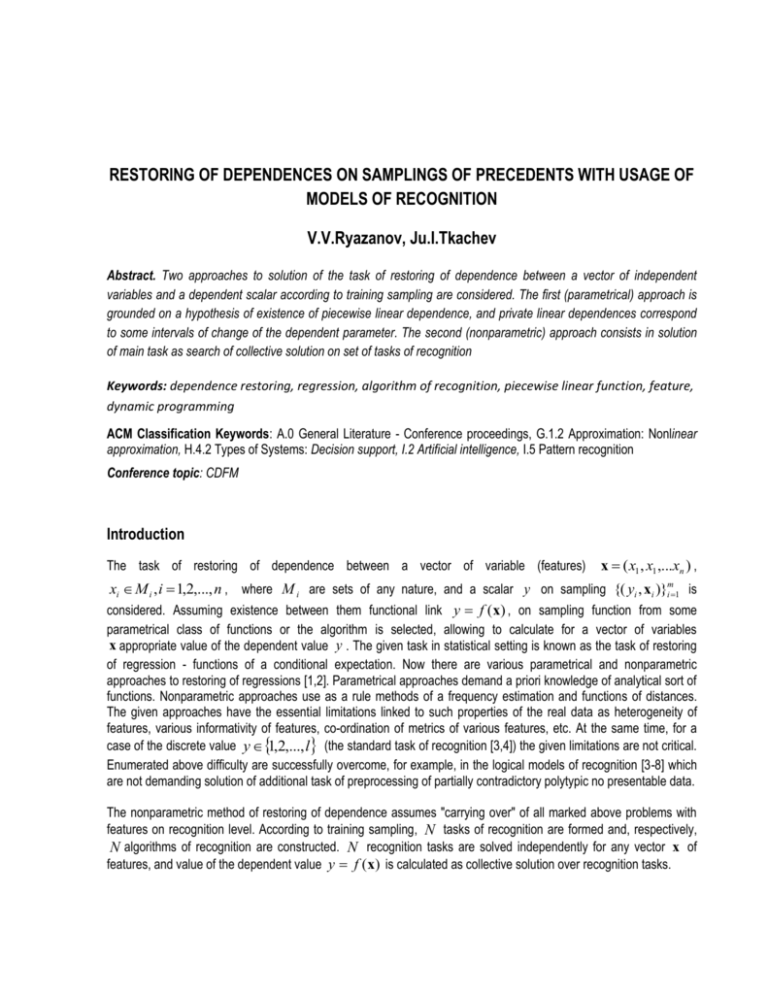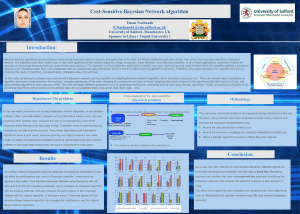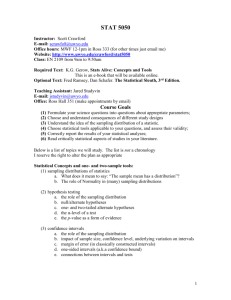RESTORING OF DEPENDENCES ON SAMPLINGS OF
advertisement

RESTORING OF DEPENDENCES ON SAMPLINGS OF PRECEDENTS WITH USAGE OF
MODELS OF RECOGNITION
V.V.Ryazanov, Ju.I.Tkachev
Abstract. Two approaches to solution of the task of restoring of dependence between a vector of independent
variables and a dependent scalar according to training sampling are considered. The first (parametrical) approach is
grounded on a hypothesis of existence of piecewise linear dependence, and private linear dependences correspond
to some intervals of change of the dependent parameter. The second (nonparametric) approach consists in solution
of main task as search of collective solution on set of tasks of recognition
Keywords: dependence restoring, regression, algorithm of recognition, piecewise linear function, feature,
dynamic programming
ACM Classification Keywords: A.0 General Literature - Conference proceedings, G.1.2 Approximation: Nonlinear
approximation, H.4.2 Types of Systems: Decision support, I.2 Artificial intelligence, I.5 Pattern recognition
Conference topic: CDFM
Introduction
The task of restoring of dependence between a vector of variable (features)
x ( x1 , x1 ,...xn ) ,
xi M i , i 1,2,..., n , where M i are sets of any nature, and a scalar y on sampling {( yi , xi )}im1 is
considered. Assuming existence between them functional link y f (x) , on sampling function from some
parametrical class of functions or the algorithm is selected, allowing to calculate for a vector of variables
x appropriate value of the dependent value y . The given task in statistical setting is known as the task of restoring
of regression - functions of a conditional expectation. Now there are various parametrical and nonparametric
approaches to restoring of regressions [1,2]. Parametrical approaches demand a priori knowledge of analytical sort of
functions. Nonparametric approaches use as a rule methods of a frequency estimation and functions of distances.
The given approaches have the essential limitations linked to such properties of the real data as heterogeneity of
features, various informativity of features, co-ordination of metrics of various features, etc. At the same time, for a
case of the discrete value y 1,2,..., l (the standard task of recognition [3,4]) the given limitations are not critical.
Enumerated above difficulty are successfully overcome, for example, in the logical models of recognition [3-8] which
are not demanding solution of additional task of preprocessing of partially contradictory polytypic no presentable data.
The nonparametric method of restoring of dependence assumes "carrying over" of all marked above problems with
features on recognition level. According to training sampling, N tasks of recognition are formed and, respectively,
N algorithms of recognition are constructed. N recognition tasks are solved independently for any vector x of
features, and value of the dependent value y f (x) is calculated as collective solution over recognition tasks.
The parametrical approach assumes that to some segments of a range of the dependent value there correspond the
linear dependences from features. The task of restoring of piecewise linear dependence is reduced to solution of the
task of dynamic programming variables in which correspond to points of splitting of a range of the dependent value on
intervals, and addends of function to be optimized define quality of approximating of dependence in an appropriate
interval by linear function.
Results of practical approbation are performed.
1. Restoring of piecewise linear dependences on samplings of precedents
We consider that training sampling {( yi , xi )}im1 , in the form of the training table Tnm where each string is a vector
of values of features and to it appropriate value of the dependent value y is set,
x11
x21
Tnm
x
m1
x1n y1
x2 n y2
. In the present section we consider that xi R, i 1,2,..., n . Without loss of
xm 2 xmn ym
generality we can consider that all yi , i 1,2,..., m are various ones and arranged on increase:
yi yi1, i 1,2,..., m 1. Let us divide a change interval y1 , ym of y (x) on l 2 intervals
1 [ y1 , yi1 ), 2 [ yi1 , yi2 ),, l [ yil 1 , ym ] . Any splitting is set by a vector of parameters
x12
x22
z ( z0 , z1 , z2 ,...zl ), zi { y1 , y2 ,..., ym }, zi zi 1, i 0,2,..., l 1, z0 y1 , zl ym .
For any segment i by data {( y j , x j ), j 1,2,..., m, } : y j i there is by means of the least squares method a
function gi (x)
n
a x
t 1
i
t t
bi in the best way approximating given subsample. Quality of the present function (and
the segment i ) is estimated as fi ( zi 1 , zi )
1
i
( y
j : y j i
j
gi (x j )) 2 . Then the task of search of the best
piecewise linear approximating with l components is formulated in the form of the following task of dynamic
programming:
l 1
( z1 , z2 ,..., zl 1 ) f1 ( y1 , z1 ) fi ( zi 1 , zi ) f l ( zl 1 , ym ) ,
(1)
zi { y2 , y3 ,..., ym1}, zi zi1 , i 1,2,..., l 2,
(2)
i2
Solving the dynamic programming task an optimal piecewise linear dependence is found. Thus the subsamples of
{( y j , x j ), j 1,2,..., m} : y j i , are set which sets of vectors x j we consider as the description of some
classes. Under descriptions of classes K i , i 1,2,..., l , some algorithm of recognition A is calculated which is
applied to classification of any new objects x .
Finally, the task of y f (x) calculation for any x is solved in a two stages: object x classification A : x K i is
carried out, further y f (x) = g i (x)
n
a x
t 1
i
t t
b i is calculated.
2. The nonparametric method of regression based on construction of collective solutions on
set of tasks of recognition
In the present section we consider that xi M i , i 1,2,..., n , M i are sets of any nature. We will take number
v m and v 1 points from a segment R y1 , ym : d 0 y1 , d0 d1 dv 1 dv ym . We receive
set R splitting into v intervals 1 [d0 , d1 ), 2 [d1 , d 2 ),, v [dv 1 , dv ] , Δ {1 ,..., v } . We will put
d k 1 d k
- interval k , k 1,2,..., v centre.
2
Let's take number 2 l v and we will define N segment R splittings into l intervals having put to each splitting
in correspondence a vector k i (ki(1) , ki( 2) ,..., ki(l 1) ), i 1,2,..., N , ki( j ) ki( j 1) n with integer positive
сk
components. The vector data sets labels intervals in appropriate splitting. Intervals 1 ,..., k (1) flagged by a label
i
«1», intervals k (1) 1 ,..., k ( 2 ) - a label «2», intervals k ( l 2 ) 1 ,..., k ( l 1) - a label « l -1», intervals k ( l 1) 1 ,..., n - a
i
i
i
i
i
label « l ». Each splitting of a segment R defines set M M1 M n splitting into l subsets (classes)
l
K1i ,..., K li : M K ti , Ki K i Ø. Splitting K i {K1i ,..., K li } is set by a rule: the object x
t 1
i
j
belongs to a class K if and only if y f (x) k and the interval k is flagged by a label « j ». Each splitting
K i defines the standard task of recognition Zi with l classes.
Let Ai - some algorithm of solution of the task Zi , carrying any object x to one of classes K ai i , ai {1,2,..., l} .
Let's consider the direct product K1 K l Δ as set of simple events. Event ( K a11 ,..., K aNN , j ) means
reference of the object x by algorithm A1 in a class Ka11 , …, by algorithm AN in a class KaNN , thus
y f (x) j . Probability of such event we will designate as (a1 ,..., aN , j ) .
According to the formula of Bayes, we have
( j a1 ,..., aN )
(a1 ,..., aN , j )
(a1 ,..., aN )
( j )
(a1 ,..., aN )
(a1 ,..., aN j ) .
(3)
N
If
algorithms
are
statistically
independent,
we
have
(a1 ,..., a N j ) ( K ai i j ) ,
i 1
N
(a1 ,..., a N ) ( K ai i ) and the formula (3) becomes (4).
i 1
( j a1 ,..., aN )
( j )
N
( K
N
( K
i 1
i
ai
)
i 1
i
ai
j).
(4)
Let's enter notations pk (k a1,..., aN ), k 1,..., v .
Function F : ( p1 ,..., pv ) R where p1 ,..., pv are received according to (3) is named as the Bayesian corrector.
Function F : ( p1 ,..., pv ) R where p1 ,..., pv are received according to (4) is named as the naive Bayesian
corrector. We will consider later the naive Bayesian corrector.
Note. We will notice that in cases when y f (x) {1,2,..., l} , the value y means a class label at classification of
the object x and the primary goal is the recognition task. Here, all splittings K i are coincide ones. For the set of
collection of recognition algorithms Ai , i 1,2,..., N , the model of the naive Bayesian corrector
F : ( p1 ,..., pv ) {1,2,..., l} in the recognition task is known (see, for example, [10]).
Definition 1. «As the answer on an average» of the Bayesian corrector for the object x , we will name the value
v
~
y p k ck .
k 1
Definition 2. «As the answer on a maximum» of the Bayesian corrector for the object x , we will name the value
~
y ck , where k arg max p j .
j
Let's describe the common algorithm of restoring of dependence y f (x) according to the training sampling,
based on usage of Bayesian model, and algorithm of calculation of value of the dependent value y for any x .
Algorithm of restoring of dependence y f (x) .
1.
Splitting of a segment R y1 , ym into intervals k , k 1,2,..., v .
2.
The calculation of splittings K i , i 1,..., N , setting of tasks of recognition Zi , i 1,..., N , a choice of
algorithms of recognition Ai , i 1,..., N , and their training.
3.
Calculation of estimations of probabilities ( K ij k ), (k ), ( K ij ), i 1,..., N , j 1,..., l , k 1,..., v.
Algorithm of calculation of value of the dependent value.
1.
Classification of the object x by algorithms Ai , i 1,..., N .
2.
Calculation of values of probabilities p1 ,..., pv according to (4).
3.
y
Calculation of ~
v
p c
k 1
k k
y ck , k arg max p j .
or ~
j
Practical implementation of the model of restoring of dependence set stated above and its application demands a
concrete definition of all resulted parameters of model and algorithms of recognition. Here can be used any
algorithms of recognition on precedents, and for calculation of estimations of probabilities – approaches and methods
of mathematical statistics. In the present paper, the use of special collection of logical algorithms of recognition (test
algorithms, algorithms of voting by representative sets, algorithms of voting by systems of logical regularities) and
heuristic estimation of probabilities is considered and proved. The common feature of the given algorithms is faultless
recognition of objects of no contradictory training sampling.
3. Restoring of dependences on the basis of application of collections of logical algorithms
of recognition
Let's put l 2 . For simplicity we consider that all values yi in training sampling are various and
yi yi 1 , i 1,..., m 1 . We will consider next two ways of construction of intervals k .
y y2
y ym
,, d m1 m1
, d m ym .
1.
We will take v m, N v 1 . We will put d 0 y1 , d1 1
2
2
For algorithm Ai intervals 1 ,..., i are marked by a label «1», the others - «2».
2.
The
minimum
value
is
founded.
We
will
put
yi 1 yi , i 1,..., m 1,
v 2m 2, N v 1 2m 3 , and d 0 y1 , d1 y1 , d 2 y2 , d 3 y2 ,,
2
2
2
2
d 2i yi 1 , d 2i 1 yi 1 ,, d v 1 ym , d v ym . For algorithm of recognition Ai , i 1,..., N ,
2
2
2
2
we will mark intervals 1 ,..., i by label «1», the others – by «2».
As frequency estimation ( K ij ), i 1,..., N , j 1,..., l , we will name a share of the objects belonging to a class
K ij in the task Z i . As frequency estimations ( K ij k ), i 1,..., N , j 1,..., l , k 1,..., v , we will name the ratio
mij( k )
mij
,
mij {xt : xt K ij } ,
where
( k ), k 1,..., v, we will name the value
mij( k ) {xt : xt K ij , yt k } .
As
a
frequency
estimation
{xt , t 1,..., m : yt k }
.
m
Definition 3. The model of restoring of dependence is named correct if for training sampling {( yi , xi )}im1 takes
yi yi , i 1,..., m .
place ~
Definition 4. The Bayesian corrector over logical algorithms of recognition with frequency estimations of probabilities
is named as model Α1 at usage of the second way of construction of intervals and «the answer on a maximum».
Theorem 1. The model Α1 at the no contradictory training information is correct.
At practical calculation of values ( K ij k ) there are situations, when pk (k a1,..., aN ) 0, k 1,..., v .
Let
d
is
~
( K ij k )
a
natural
number.
We
will
' ( K ij k )
consider
m
t m
ki dn,n ) (
w
( K ij k )
t k
ak dx,1) (
,
and
' ( K ij k )
. Here d is named as width of a window of smoothing, and nonnegative
v
( t )
i
' ( K j t )
i
t 1 ( K j )
~
values wd ,..., wd are smoothing scales. It is visible that, ( K ij k ) 0 ,
v
(
k 1
k
~
)( K ij k ) ( K ij ) , i.e.
~
~
( K ij k ) are conditional probabilities formally. Replacement process ( K ij k ) ( K ij k ) we will name as
smoothing. In addition, we will set superimpose limitation of symmetry wt wt , t 1,..., d , and character of
decrease w0 2 w1 4 w2 2 d wd . We will name модель Α1 as model Α 2 at usage of procedure of
smoothing with exponential function of scales. The Theorem 2 is correct.
Theorem 2. The model Α 2 at the no contradictory training information is correct one
4. Experimental matching of models of restoring on the model data
It is spent three sorts of experiments for matching of the nonparametric method of restoring of dependences offered in
the present article with linear regression and the nonlinear regression grounded on nuclear smoothing.
1. Matching on elementary functions. For the first experiment the elementary nonlinear one-dimensional
dependences (a parabola and a sinusoid) are used. On fig. 1, 2 results of matching of the restored dependences with
true on some segment on an example of one-dimensional dependences y x 2 and y sin( x) are resulted. In the
task "parabola" training sampling was under construction by a rule xi 2i, yi ( xi ) 2 , i 1,...,50 , and control
sampling – by a rule xi i, yi ( xi ) 2 , i 1,...,100 . In the task "sinusoid" training sampling was under construction
by a rule xi 2i, yi sin(
2
2
xi ), i 1,...,50 , and control – by a rule xi i, yi sin(
xi ), i 1,...,100 . In
100
100
figures 1,2 plots of dependences and results of their restoring are shown, in table 1 norms of vectors of errors of
each of algorithms on the given tasks are presented.
Figure 1. The model problem "parabola"
Figure 2. The model problem " sinusoid "
Task
Parabola
Linear regression
6.52
Bayesian corrector
0.31
Nuclear smoothing
0.64
Sinusoid
810
11321
Table 1.
1138
2. Matching on the data with noise. There were considered 10 various two-dimensional normal distributions. Means
and dispersions of distributions were selected according to the uniform law of distribution. According to each of
(1)
( 2)
R are
normal laws of distribution samplings of 12 points which have been united in one {( xi(1) , xi( 2 ) )}120
i 1 , xi , xi
received. The target variable y coincides to within the sign with density of appropriate normal distribution. For the
first 5 normal samples value y was the density, for the others – density with the sign a minus. Variables
x (1) , x ( 2) have been added noise x (3) ,, x ( 49) , subordinates to the uniform law of distribution. The sampling
{( xi(1) , xi( 2) ,, xi( 49) , y )}120
i 1 generated as a result has been divided casually into training and forecasting
samplings of 90 and 30 points, accordingly.
3. Matching on tasks with discrete features. Sampling of 200 3D objects according to a following rule is generated:
- xi(1) , xi( 2 ) implementations of a random variable 0,...,10 with probabilities
x ( 3) ,
( 3)
x
considered the dependence y
1
, xi( 3) i, i 1,...,200 . It was
11
x (1) x ( 2 ) ,
The generated sampling was considered divided casually
x (1) x ( 2 ) .
on two on 100 objects (training and forecasting).
In Table 2 norms of vectors of errors of the algorithms, averaged on 10 independent experiments are resulted.
The task
Bayesian corrector
Linear regression
Nuclear smoothing
Data with noise
3.625
4.489
4.150
Discrete features
552.1
850.7
606.2
Table 2.
Results of experiments show a high accuracy of the Bayesian corrector, its ability successfully to handle data with
noise and the different type data at rather small training samplings.
5. Conclusion
In a method of restoring of piecewise linear dependences it was supposed that the number of linear components is
set. Clearly, that the criterion ( z1 , z 2 ,..., zl 1 ) monotonously does not increase with growth of number of
components and, therefore, cannot be used for definition of l . The true number of components can be found by
exhaustive search of a small number l with calculation of ( z1 , z 2 ,..., zl 1 ) in a mode of the cross-validation.
The Bayesian corrector for calculation of values of the dependent value is not the unique way grounded on problem
solving of recognition. Here other approaches are possible which are developed now by authors.
The study was supported by Russian Foundation for Basic Research (projects № 08-01-00636, 09-01-00409, 09-0112060-ofi_м), and by target program № 14 of Russian Academy of Sciences
Bibliography
[1] Drejper Н, Smith G. Applied regression analysis. M.:Pablishing house Williams, 2007.
[2] Hardle B. Applied nonparametric regression. М, The World, 1993.
[3] Zhuravlev Ju.I. Correct algebras over sets of not correct (heuristic) algorithms. I. Cybernetics. 1977. N4. pp. 5-17.,
II. Cybernetics, N6, 1977, III. Cybernetics. 1978. N2. pp. 35-43.
[4] Zhuravlev Ju.I. About the algebraic approach to solving of recognition or classification problems. Cybernetics
problems. М: The Science, 1978. 33. pp.5-68.
[5] Dmitriev A.N., Zhuravlev Ju.I., Krendelev F.P., About mathematical principles of classification of subjects and the
phenomena. The transactions "The Discrete analysis". Issue 7. Novosibirsk, IM SB AS USSR. 1966. pp. 3-11
[6] Baskakova L.V., Zhuravlev Ju.I. Model of recognising algorithms with representative sets and systems of basic
sets//Zhurn. vichisl. matem. and matem. phys. 1981. Vol.21, № 5. pp.1264-1275
[7] Ryazanov V.V. Logical regularities in recognition tasks (the parametrical approach)// Zhurn. vichisl. matem. and
matem. phys. 2007. Vol.47, № 10. pp.1793-1808
[8] Zhuravlev Ju.I., Ryazanov V.V., Senko O.V. Pattern recognition. Mathematical methods. The program system.
Applications. - Moscow: Phasys publisher, 2006, 176 p.
[9] Sigal I.H., Ivanov A.P. Introduction in applied discrete programming: models and computing algorithms. The
manual. М: PHYSMATLIT, 2002, 240 p.
[10] P.Domingos and M.Pazzani. On the optimality of the simple Bayesian classifier under zero-one loss. Machine
Learning, 29:103-130, 1997.
Authors information
Vladimir Ryazanov – Professor, Heard of Department; Institution of Russian Academy of Sciences
Dorodnicyn Computing Centre of RAS, Russia, 119991 Moscow, Vavilov's street, 40; e-mail:
rvv@ccas.ru
Major Fields of Scientific Research: Pattern recognition, Data mining, Artificial Intelligence
Yury Tkachev – The post-graduate student; Institution of Russian Academy of Sciences Dorodnicyn
Computing Centre of RAS, Russia, 119991 Moscow, Vavilov's street, 40; e-mail:
tkachevy@gmail.com
Major Fields of Scientific Research: Pattern recognition, Data mining, Artificial Intelligence








